Introduction
Intelligent Document Processing (IDP) is revolutionizing how we manage unstructured data in documents. By leveraging artificial intelligence and automation, IDP utilizes machine learning and natural language processing to accurately interpret, categorize, and process data from various document types. This innovative technology goes beyond traditional OCR by understanding context and extracting pertinent information.
IDP is versatile, with applications across sectors such as banking, healthcare, and government, driving efficiency and simplifying complex document-related operations. Leading vendors offer sophisticated solutions that integrate AI, ML, and NLP, significantly cutting down on manual processing and associated costs. With IDP, businesses can witness marked improvements in operational efficiency and productivity.
What is Intelligent Document Processing (IDP)?
Using artificial intelligence and automation, Intelligent Document Processing (IDP) is revolutionizing our interaction with unstructured information in paperwork. At its essence, IDP utilizes machine learning and natural language understanding to precisely interpret, categorize, and handle information from different types of records. This innovative technology goes beyond traditional OCR by not only converting text from images but by understanding the context and extracting pertinent information such as names and dates. IDP’s versatility is evidenced by its application across diverse sectors—be it banking, healthcare, or government—where it drives efficiency, minimizes errors, and simplifies complex document-related operations. Significantly, it plays a crucial role in handling vital paperwork such as loan applications and medical records. Prominent suppliers in IDP provide advanced solutions that incorporate AI, ML, and NLP to transform workflows for managing documents, effectively reducing reliance on manual procedures and the expenses that come with them. Consequently, companies that utilize sophisticated handling of written records are experiencing a significant enhancement in operational effectiveness and productivity.
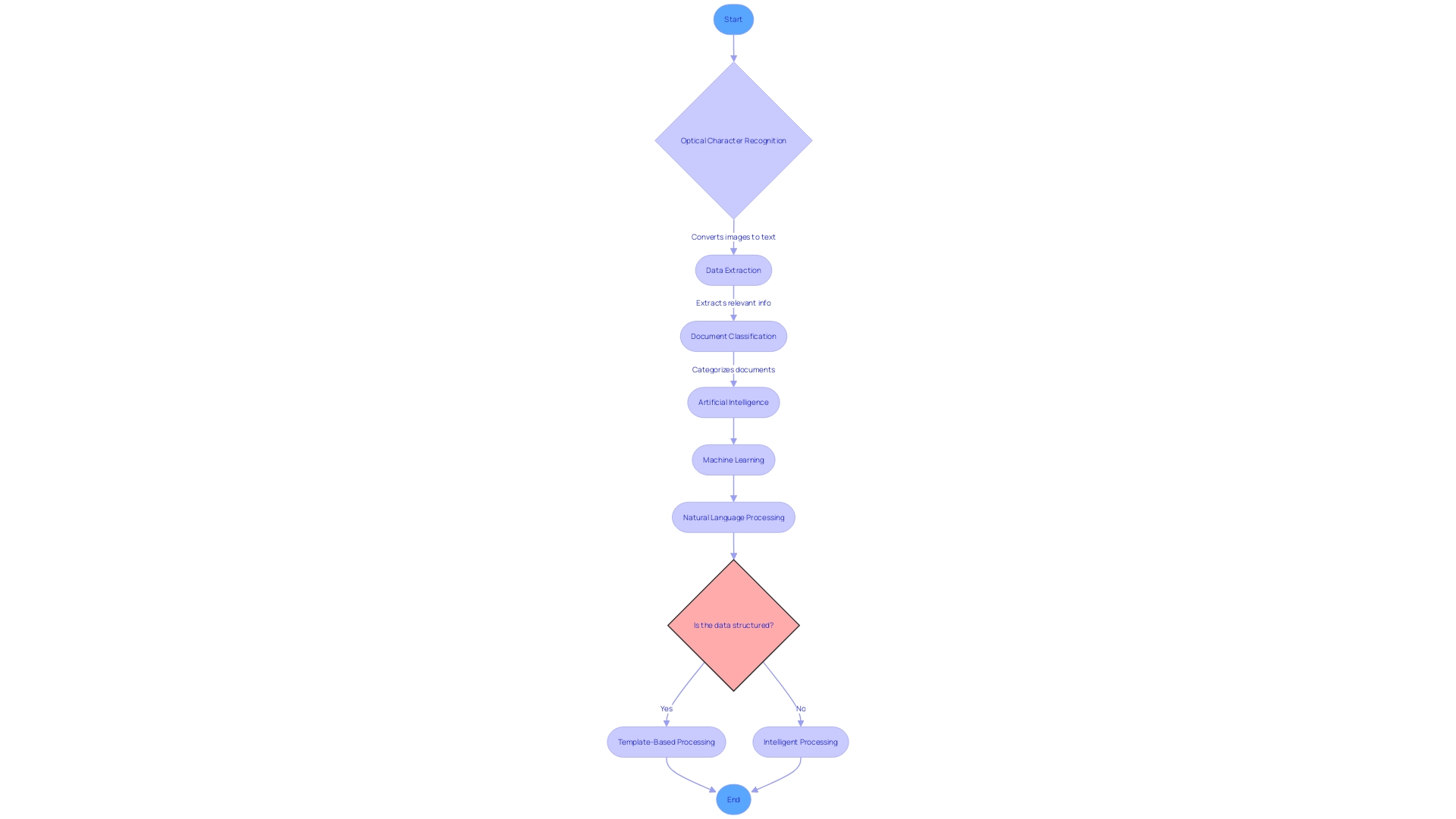
Technologies Used in Intelligent Document Processing
Harnessing the power of AI and machine learning, Intelligent Document Processing (IDP) is transforming the way organizations handle an ever-increasing volume of documents. IDP systems are equipped with Optical Character Recognition (OCR) to transform printed materials into digital text, enabling further processing and analysis. Natural Language Processing (NLP) plays a crucial role by understanding the intricacies of human language, extracting essential information, and categorizing information for effective utilization. Machine Learning (ML) algorithms empower IDP to identify patterns, predict outcomes, and automate decisions based on vast datasets, becoming smarter over time. Furthermore, the incorporation of Robotic Process Automation (RPA) eliminates the monotony from tasks such as information input, ensuring that repetitive actions are carried out with velocity and accuracy. As industries handle data-intensive tasks, from healthcare to insurance, IDP stands out as a sophisticated solution to navigate, manage, and utilize extensive volumes of information, driving efficiency and reducing the margin for error in vital document-related workflows.
Stages Involved in Intelligent Document Processing
Intelligent Document Processing (IDP) is a multifaceted approach, harnessing the power of cutting-edge technologies to transform unstructured data management. At its core, IDP incorporates:
- Optical Character Recognition (OCR): This technology transforms text from scanned documents into a machine-readable format, acting as a cornerstone for further processing.
Data Extraction: An essential stage where particular information such as names, dates, and addresses are identified and pulled from paperwork. - Content Categorization: Through content analysis, IDP systems have the ability to classify information into predefined groups, thereby improving organization and retrieval efficiency.
These capabilities are not just theoretical; they are revolutionizing industries. In banking, IDP accelerates loan handling, while in healthcare, it manages patient records with newfound agility, ultimately streamlining operations and reducing manual labor costs.
On the technological front, the combination of AI, ML, OCR, and NLP within IDP solutions from top vendors is revolutionizing the landscape of workflow automation. As industries such as insurance and healthcare experience significant changes, the implementation of IDP plays a crucial role in this development, automating the handling of large amounts of paperwork accurately.
For businesses seeking to harness these benefits, selecting the right IDP software is a strategic decision. It’s vital to align the choice of software with the organization’s specific needs – a task that requires a deep understanding of both the capabilities of the technology and the unique challenges of the industry.
Stage 1: Document Pre-Processing
The procedure of preparing papers for improved operational treatment involves thorough preparation. It encompasses the scanning of physical papers, the conversion of various file types into digital formats, and the careful removal of extraneous noise or irrelevant elements. To effectively manage the complexity of data from diverse sources, it’s essential to meticulously format the information to fit the requirements of advanced processing systems. Intelligent Document Processing (IDP) leverages technologies such as Optical Character Recognition (OCR) and Machine Learning (ML) to convert text from scanned images into a machine-readable format and extract pertinent details like names, dates, and addresses with precision.
For example, when managing a wide range of enterprise content, IDP systems must navigate through a variety of file types, which may consist of plain and formatted text, images, tables, barcodes, and even handwritten notes or logos. The diversity in file formats and the quality of images can present significant challenges, but IDP solutions employ advanced algorithms to process these effectively. By incorporating Natural Language Processing (NLP), these systems acquire the ability to comprehend the context and subtleties within the texts, thereby improving the precision of information retrieval and summarization.
Additionally, in sectors like banking, healthcare, insurance, and government, the automation of processing paperwork with IDP solutions can result in significant efficiency improvements. By automating the extraction and management of information, these intelligent systems minimize the need for manual intervention, reduce error rates, and expedite operations. To demonstrate the effectiveness of this technology, more than 3,500 security professionals support the strength of these systems, guaranteeing security and confidentiality while offering affordable methods for extracting valuable information from written material.
Stage 2: Processing Stage
Using OCR (Optical Character Recognition) technology, the conversion of different textual sources like images, videos, and scanned files into editable digital text is accomplished. This transformation is crucial, as it enables computers to interpret, modify, and explore the information, improving automated information input, record digitization, and availability. Once OCR has completed its task, the next step involves deploying sophisticated NLP (Natural Language Processing) algorithms to dissect the extracted text. These algorithms are skilled at identifying vital elements, discerning connections, and locating specific information fields within the text.
The complex logic necessary to derive structured data from unstructured text is often highly specialized, relying on intricate techniques tailored to specific types of files. This could involve the use of advanced OCR services like AWS Textract, which enable key-value pair extraction, or intricate regular expressions to navigate the text. However, these methods, while effective, often fall short when confronted with differences in layout formats.
The emergence of large language models, trained on extensive corpora, has greatly streamlined this process. These models hold the capability to effortlessly extract attribute information given a contextual background and a predefined schema, which marks a substantial improvement over traditional extraction methods.
The implications of these advancements are far-reaching, impacting various sectors from healthcare, where patient records can now be digitized with greater accuracy, to the legal field, where analysis of papers has been expedited. In a dynamic technological landscape, intelligent information processing stands firm as an indispensable tool for operational efficiency.
Stage 3: Data Classification and Extraction
ML models have advanced to the point where they are essential in classifying and extracting key information from different types of records. For example, classification algorithms are skilled at differentiating between invoices, contracts, forms, and other categories. Concurrently, information extraction models excel in pinpointing and harvesting specific data fields such as names, addresses, and invoice numbers. This complex procedure usually involves employing natural language processing (NLP) methods, which may require creating specialized components to analyze texts. These modules, which may rely on OCR services like AWS Textract or intricate regular expressions, facilitate key-value pair extraction. The true challenge lies in crafting logic that can adapt to different document layouts, a task that previously required creating complex and specific solutions that did not generalize well.
However, the emergence of large language models (LLMs) trained on vast corpora has significantly eased this burden. These LLMs are now capable of effortlessly extracting attribute information given the right context and schema. They offer a more scalable solution that can keep pace with the rapid advancements in our field, unlike one-off human evaluations or processes that quickly become outdated. Such models not only provide a repeatable evaluation process but also allow sharing with others for consistent LLM quality assessment.
Stage 4: Data Validation
To guarantee that information serves its intended purpose effectively, it must pass through rigorous validation checks after extraction. These checks are not just about confirming the presence of information; they delve deeper to ascertain its semantic correctness and consistency. Validation rules are created to verify if the information is complete, accurately formatted, and logically consistent. These criteria are pivotal to maintaining the high information quality that is critical for informed decision-making and innovation. Accurate and reliable information underpins the agility of a business, enabling it to respond swiftly to market changes and customer needs while safeguarding its reputation. As information becomes an ever more valuable asset, the integrity of this information is paramount, ensuring it remains unaltered and as valuable as when it was first created or captured.
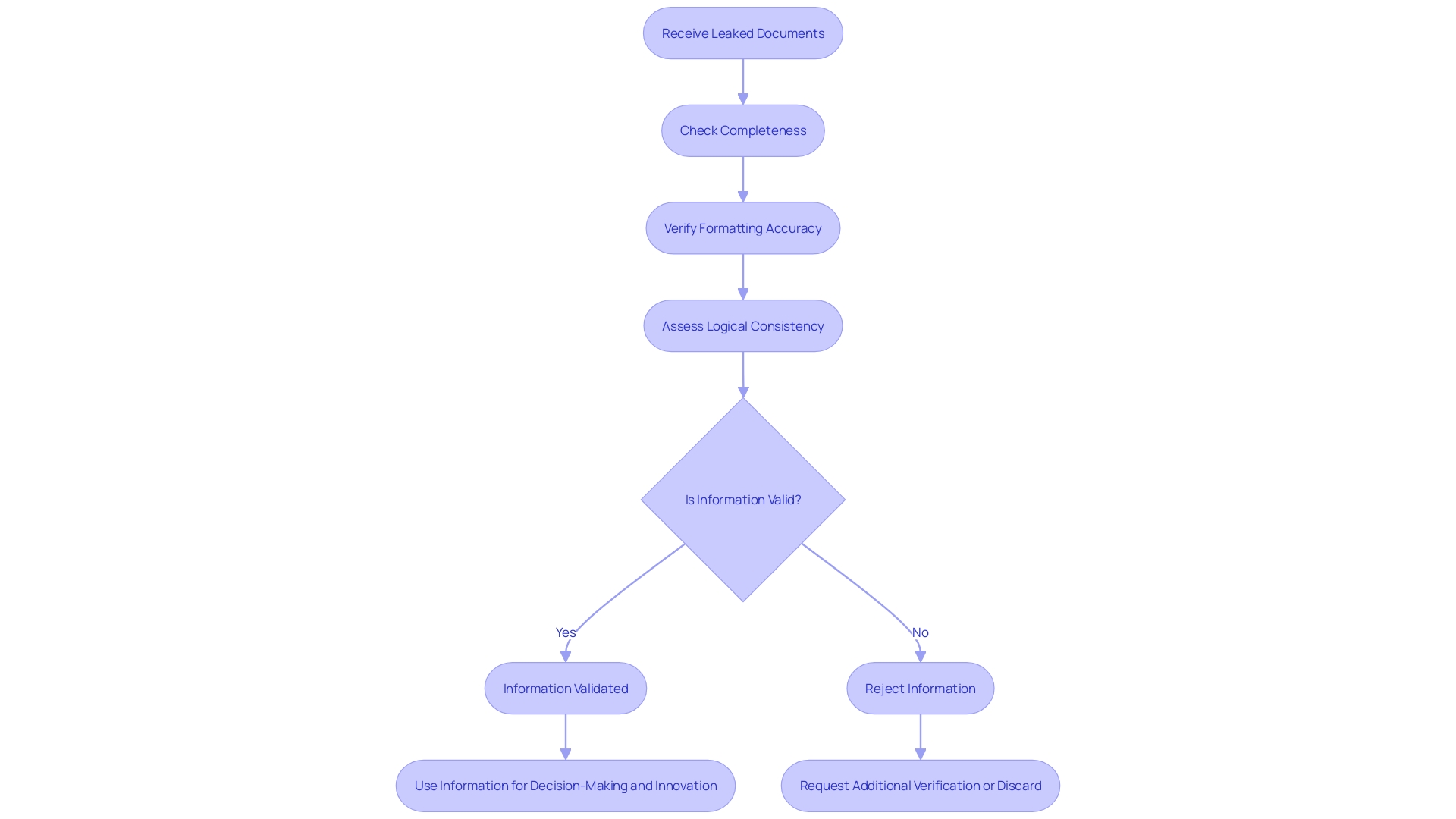
Stage 5: Integration and Workflow Automation
After successfully extracting information from different sources, the process of integrating this information into other systems begins. This process paves the way for increased operational effectiveness through the automation of document-driven workflows. Using RPA (Robotic Process Automation) technology, information can seamlessly be channeled into corresponding applications, databases can be updated, and a series of subsequent activities can be initiated. These activities range from the generation of comprehensive reports to the dispatch of notifications, creating a streamlined organizational ecosystem.
The value of such integrations was underscored in the case of Lindy, an AI assistant designed to automate a gamut of tasks. Lindy faced the daunting task of integrating a vast network of applications and services to empower their AI assistants to execute requests efficiently. The challenge was monumental, involving extensive research and development, with projections of a year-long timeline, which could have delayed their market entry. Yet, the integration of these systems is critical for harnessing the full potential of intelligent automation.
Recent statistics bolster the importance of this integration phase, revealing that two-thirds of businesses are actively refining their workflow automation processes, indicating a widespread move toward automation maturity. Moreover, a majority of these enterprises anticipate a return on investment within 12 months post-implementation, underscoring the economic benefits of an automated workflow.
The merging of intelligent processing (IDP) with automated workflows signifies the subsequent frontier in information management. This method not only tackles the inefficiencies of manual input but also utilizes the capabilities of AI and ML to interpret unstructured information. By doing so, organizations can unlock actionable insights from papers that were previously mired in complexity, thereby catalyzing smarter decision-making and process optimization.
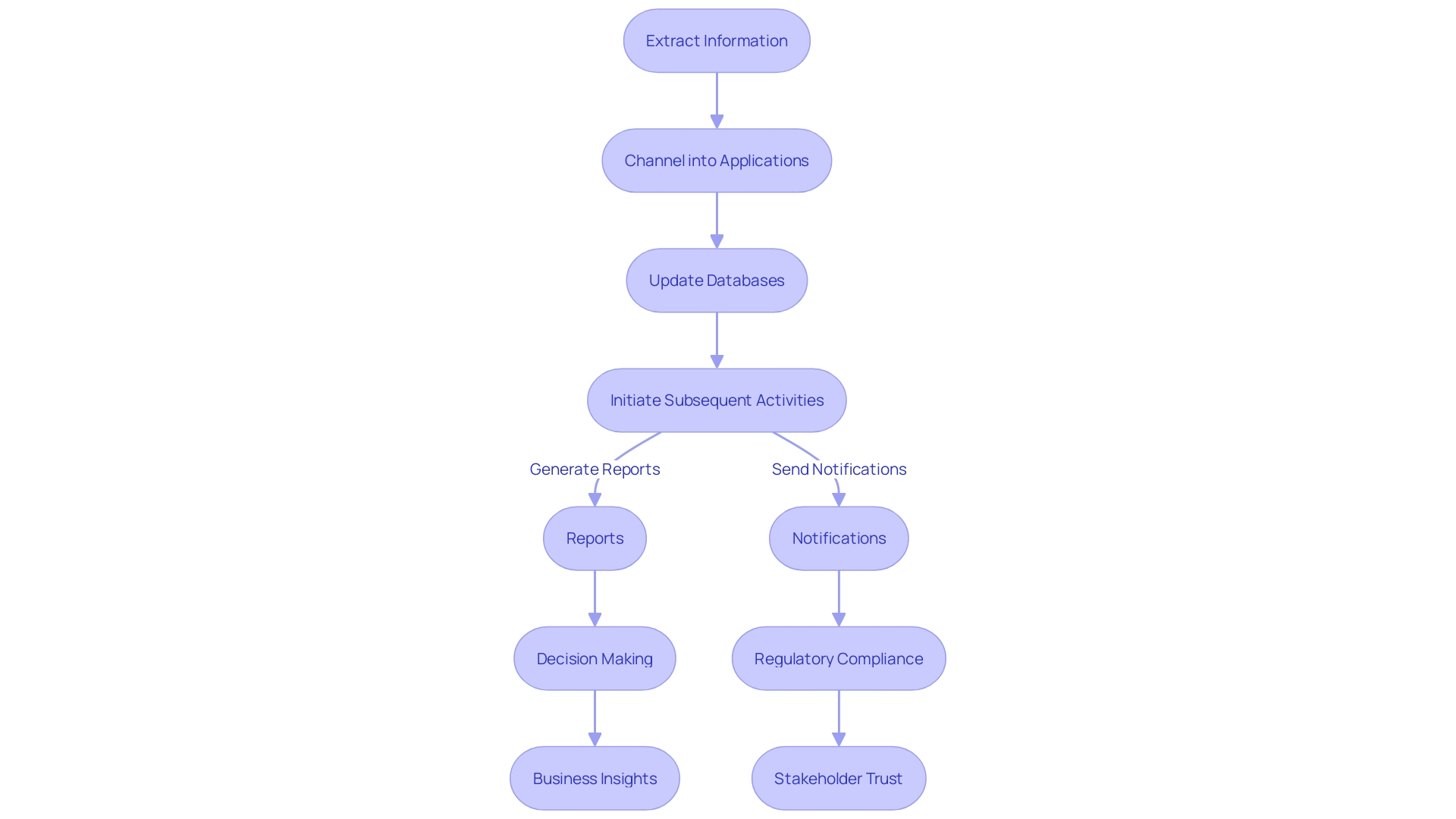
Benefits of Intelligent Document Processing
Leveraging the potential of Intelligent Document Processing (IDP) turns the laborious task of managing unstructured information into a streamlined, error-minimized process. By incorporating cutting-edge technologies such as AI, ML, and RPA, IDP surpasses the constraints of manual data entry and handling of records. This technological advancement is especially advantageous for big organizations that handle paperwork on a massive level, where effectiveness equals competitive edge. IDP is a beacon of digital transformation, providing enterprises with the tools to automate the extraction, classification, and handling of documents. Its impact is notably profound in the insurance sector, where IDP is revolutionizing information management by unlocking the value in the 85% of enterprise information that is unstructured. Whether it’s processing claims forms or organizing underwriting files, IDP equips insurers to rapidly access and utilize their data, optimizing speed without sacrificing accuracy. For any organization considering IDP, a strategic evaluation of their specific requirements and objectives is paramount. Both the insurance and healthcare industries have seen substantial improvements by adopting IDP, despite their diverse needs. The technology not only saves time and resources but also drastically reduces the likelihood of human error, fostering greater operational productivity across the board.
Scalability and Efficiency
Intelligent Document Processing (IDP) represents a significant leap forward in the realm of file management. By utilizing the capabilities of Artificial Intelligence (AI) and Machine Learning (ML), IDP systems can analyze and extract information from a diverse range of materials, whether they are organized, partially organized, or unorganized. This adaptability is vital for businesses overwhelmed with papers of different types and quality, where conventional techniques like Optical Character Recognition (OCR) have not met expectations, particularly with flawed papers.
The IDP workflow starts with information acquisition, a stage where records are extracted from different sources such as emails, compiled, and securely stored for processing. The ability to manage the large amount of paperwork without requiring manual categorization significantly speeds up the procedure. After capturing data, the system effectively extracts information, even from materials that do not adhere to a standard format, which is a typical obstacle in manual processes.
The demand for fast paperwork processing is driven by the need for shorter decision cycles critical for business operations. IDP technology addresses this by minimizing the time and costs associated with manual workflows, thereby augmenting productivity, responsiveness, and the capacity for data-driven innovation.
An illustrative example of IDP’s transformative impact can be seen in the insurance industry, which is undergoing a significant revolution thanks to IDP. Millions of vital patient records are handled every year, many of which had historically demanded painstaking manual examination. With IDP, these processes are automated, leading to considerable time and cost savings.
Moreover, the progress of automation technologyâfrom the basic tools of the late 20th century to today’s advanced IDP solutionsâreflects the significant advancements in computing and AI. These technologies have evolved from simple word processors to systems capable of comprehending context and making intelligent choices, transforming how companies handle their workflows.
As the digital landscape continues to evolve, IDP stands at the forefront, blending AI, robotic process automation, and analytics to propel enterprises towards digital transformation. Those who incorporate IDP can expect to see remarkable improvements in efficiency, a reduction in human errors, and a notable increase in productivity.
Cost-Efficiency and Reduced Overhead
Intelligent Document Processing (IDP) is transforming the way organizations manage their information, particularly unstructured and semi-structured records. By leveraging the capabilities of machine learning algorithms and artificial intelligence, IDP systems are transforming manual paperwork management tasks into automated, efficient processes. This technological advancement is not only enhancing productivity but also significantly reducing operational costs. One of the main benefits of IDP is the capability to process large quantities of information with enhanced precision, eliminating the requirement for time-consuming manual review. For instance, healthcare insurance providers who implement IDP can effectively handle patient records, saving numerous hours and financial resources previously allocated to manual data entry and correction. Furthermore, IDP supports financial and technology teams in aligning their efforts, fostering a collaborative environment that emphasizes cost management and optimization. The implementation of IDP aligns with the principles of the Cost Optimization pillar in the Well-Architected Framework, emphasizing the importance of continuous refinement throughout a workload’s lifecycle to achieve business outcomes while minimizing expenses. Companies that utilize IDP can not only streamline their paperwork but also obtain information that leads to improved financial management and a more profitable return on investment. As businesses navigate through the ever-changing landscape of digital transformation, the strategic adoption of IDP is proving to be a powerful tool in driving innovation, reducing errors, and freeing up valuable resources to focus on strategic, high-level tasks.

Enhanced Customer Satisfaction
Intelligent Document Processing (IDP) solutions are revolutionizing customer interactions across different sectors by offering fast processing of files and improving the precision of data given to customers. For example, a bustling hotel like Travel Charme Strandhotel Bansin, which caters to a significant number of guests, leverages such technologies to streamline operations and improve guest satisfaction. With IDP, hotels can swiftly process customer requests, check-ins, and check-outs, ensuring a seamless experience that encourages repeat visits and positive reviews.
The impact of IDP on customer satisfaction is further highlighted by a recent report which found a global decline in customer satisfaction across numerous brands. However, brands that have effectively combined technology with a personalized customer experience stand out for their ability to meet and exceed customer expectations. These findings emphasize the necessity for companies to select IDP solutions that not only automate processes but also contribute to a holistic and humanized customer experience.
For organizations considering IDP, it’s crucial to identify processes that would benefit most from automation, such as identity verification and simple order inquiries. By starting with straightforward applications, companies can achieve quick wins and set the stage for more complex integrations. This approach aligns with recent statistics showing the importance of a frictionless customer experience, particularly in e-commerce, where simplifying the checkout process can lead to significant increases in conversion rates.
Moreover, integrating IDP solutions with a customer-centric strategy can lead to long-term benefits, as noted by industry experts. Respecting customers’ time and providing swift, accurate service are foundational elements of customer satisfaction. In an era where customer expectations evolve with technological advancements, IDP serves as a critical tool for businesses to maintain a competitive edge in delivering exceptional customer service.
Continuous Learning and Improvement
Intelligent Document Processing (IDP) systems redefine how we approach unstructured information management by harnessing the power of machine learning to adapt and excel over time. By being exposed to new datasets and variations in types of information, these systems develop to handle data with greater accuracy, guaranteeing that the IDP solutions you implement today will be even more effective in the future. Leveraging advanced techniques such as keyword extraction, similarity comparisons, and natural language database queries, IDP systems can distill ‘data-rich’ but ‘knowledge-poor’ content into actionable insights.
Think about the revolutionary effect of such a system on a company overwhelmed with PDF files, where manual information input caused delays and pile-ups. By integrating IDP, not only was the workflow accelerated, but it also facilitated a more collaborative and efficient operational environment, echoing Matt Mullenweg’s vision of technology uniting people. This is not a standalone instance; from the German patent office to innovative tech firms, the application of IDP systems has proven to be a game-changer.
The significant advancement in processing is strengthened by the adoption of a microservices architecture, ensuring scalability and resilience. As part of an ecosystem that includes IDS and its commitment to AI innovation, IDP solutions represent the pinnacle of operational efficiency. Moreover, utilizing platforms like Kaggle enables continuous model enhancement, drawing from a wealth of science expertise to further refine these dynamic systems.
Ultimately, IDP systems don’t just learn; they revolutionize. By continuously adapting to new challenges and data, they mark a significant leap towards creating a more efficient, effective, and intelligent operational framework, fulfilling the promise of continuous improvement and innovation in file management.
Reporting and Analytics
Intelligent Document Processing (IDP) is transforming the way organizations manage large quantities of paperwork, shifting from manual and time-consuming duties to automated, streamlined workflows. By utilizing the power of artificial intelligence (AI), machine learning (ML), and robotic process automation (RPA), IDP systems are not only expediting the handling of papers but also significantly reducing mistakes. These cutting-edge technologies empower the retrieval and categorization of information from unorganized or partially organized files, converting them into practical observations and efficient procedures.
The capabilities of IDP go beyond mere data handling; they provide comprehensive analytics that offer visibility into how papers are handled. This enables companies to examine times of operation, detect obstacles, and locate errors or discrepancies in record handling. With these insights, businesses are better equipped to refine their workflows, thereby enhancing overall productivity.
The effect of IDP can be observed in sectors like insurance, which are experiencing substantial changes due to IDP’s capacity to automate the handling of intricate paperwork. Similarly, healthcare providers, who manage millions of crucial patient records, are now able to expedite manual reviews, reducing time and financial expenditures associated with these processes.
The development of automation in records, from the rise of word processors to the present era of AI-driven IDP, emphasizes the ongoing pursuit of efficiency and accuracy in data management. Today, businesses overwhelmed with laborious, manual review processes have a viable alternative in IDP platforms, which free employees from the most tedious aspects of their jobs, allowing them to concentrate on more strategic tasks.
As the scenery of record handling develops, it is crucial for organizations to contemplate IDP solutions that align with their specific requirements and goals. By doing so, they can leverage the full potential of intelligent automation to drive digital transformation and achieve operational excellence.
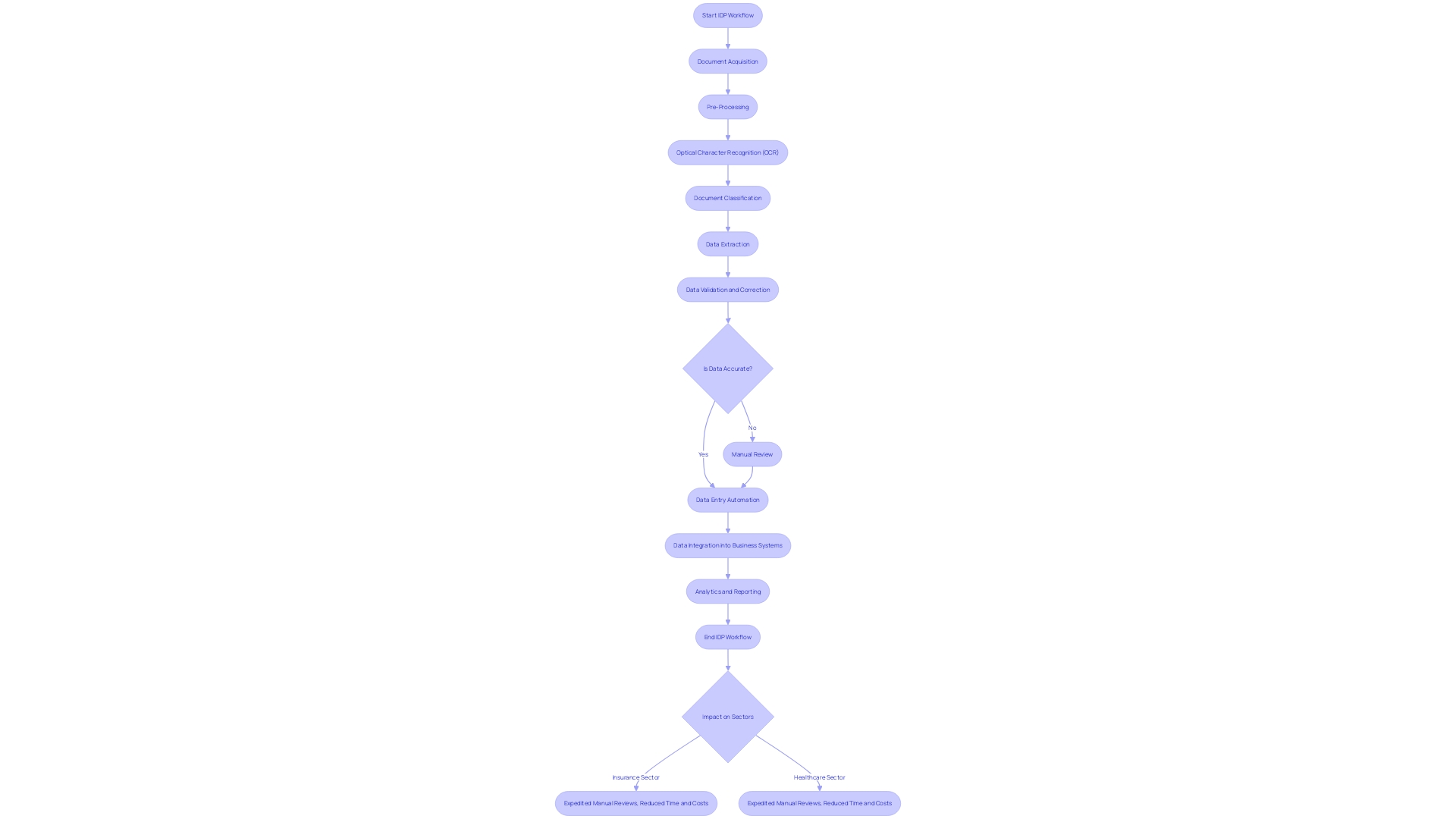
Use Cases for Intelligent Document Processing
Utilizing the power of Intelligent Document Processing (IDP), different industries are transforming their information management and operational processes. IDP solutions leverage artificial intelligence, machine learning, and advanced computational techniques like optical character recognition (OCR) and natural language processing (NLP) to automate the extraction and processing of data from records. This technology is proficient in managing a variety of tasks including information extraction, classification, and text recognition, which are crucial for transforming unstructured information into actionable insights.
- Optical Character Recognition (OCR): This is the foundation of IDP, converting scanned files into searchable and editable text, facilitating seamless digital archiving and information retrieval.
- Data Extraction: IDP systems skillfully extract key information like names, dates, and addresses, streamlining data entry and minimizing errors.
- Classification: By categorizing files into pre-defined groups, IDP enhances file organization and retrieval processes.
Industries such as banking, healthcare, legal, insurance, and government are adopting IDP to process loan applications, insurance claims, legal contracts, and medical records more efficiently. This adoption is not just a trend; it’s a strategic move towards digital transformation, evidenced by reduced human errors and significant productivity gains. Organizations utilizing IDP observe significant enhancements in processing times and cost savings, demonstrating the profound influence of intelligent automation in record management.
Customer Service Automation
Intelligent Document Processing (IDP) solutions revolutionize customer service by automating the handling of various customer-related files. By focusing on tasks that are manual, repetitive, and costly such as support tickets, emails, and feedback forms, IDP allows businesses to prioritize efficiency and customer satisfaction. Automating identity verification and simple inquiries like order statuses are now within easy reach, offering rapid response times and effective ticket management. A significant 67% of customers show a preference for self-service options rather than speaking directly to service representatives, emphasizing the need for robust automation systems.
The incorporation of IDP into customer service workflows not only meets the demands of contemporary customers for prompt and high-quality support but also corresponds with the advancement of automation in records over time. From the early days of word processors to the sophisticated AI-driven platforms of today, the focus has always been on reducing manual effort and elevating productivity. With the recent advancements announced by companies like MuleSoft, the potential to transform everyday paperwork workflows and minimize human intervention is exciting. This approach is not just about leveraging new technologies but about adapting to the future of work where efficiency and innovation go hand in hand.
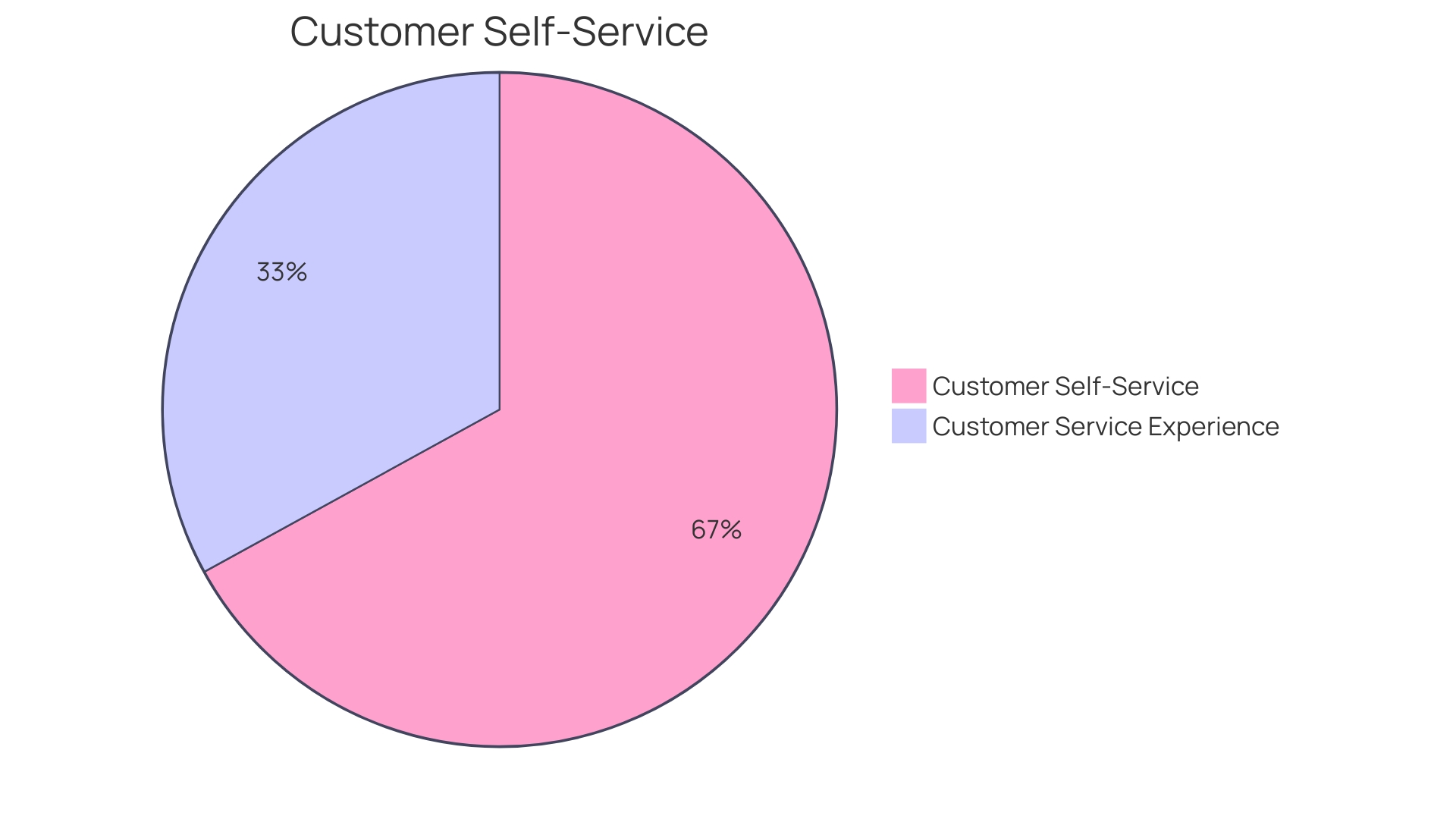
Contract Management
The coordination of contract management is no easy job, with its elaborate choreography of handling multiple papers, all filled with important information. Intelligent Document Processing (IDP) solutions are at the forefront of transforming this elaborate performance into a seamless and automated flow. By harnessing the power of IDP, key terms and conditions are meticulously extracted, and the entire contract lifecycle is managed with precision. This leap in technology not only ensures heightened compliance but also significantly diminishes risks. Moreover, it streamlines contract management workflows, paving the way for a more robust and efficient system.
Consider the case of Somerset Academies of Texas, where disjointed software systems for various institutional needs led to inefficiencies and dropped information. The introduction of integrated solutions exemplifies the transformative effect of IDP. Similarly, Delivery Hero’s adoption of IDP curbed the time-consuming process of account recovery, which previously took a toll on employee productivity. These narratives echo the sentiment that contracts are the bedrock of commerce, a notion that has driven partnerships like Icertis and Microsoft to pioneer AI-driven contract intelligence. This technology not only allows for the extraction of insights from contracts but also aids in fulfilling commercial agreements’ original intentions.
Recent developments, such as the presence of Internet Computer at significant Swiss events, highlight the growing recognition of digital solutions’ role in the future of contract management. In line with this trend, the ‘State of Contract Management’ white paper indicates an increasing reliance on digital tools for contract management, pointing to a more digital future for contract managers.
Statistics further support the case for IDP, with reports identifying key considerations for intelligent automation, including information and preparedness, and human talent. These reports offer an action guide with an 11-point blueprint for optimizing intelligent automation, exemplifying the shift towards digital transformation. As businesses continue to deal with the extensive expansion of documents, the implementation of IDP solutions, equipped with AI, ML, and RPA, becomes essential for managing unstructured information with unparalleled efficiency and accuracy.

Invoice and Payment Processing
Intelligent Document Processing (IDP) serves as a transformative force in improving business workflows, particularly in the domain of invoice and payment management. By leveraging the capabilities of AI and machine learning, IDP solutions extract vital information from invoices with high precision, thus enhancing the efficiency of the accounts payable function. This automation not only minimizes human errors but also expedites the payment cycle, which is instrumental in achieving superior cash flow management. Such advancements in file processing technology have been proven to deliver substantial operational efficiencies and productivity boosts, reflecting the innovative strides made since the inception of file automation decades ago.
Data Extraction and Document Processing
Intelligent Document Processing (IDP) represents a paradigm shift in how enterprises handle diverse documentation. By integrating artificial intelligence and machine learning, IDP platforms offer a dynamic approach to managing both structured and unstructured data. In contrast to conventional OCR systems, IDP performs exceptionally well in interpreting and condensing the contents of files, even when confronted with diverse formats and quality levels. This flexibility is essential in a business environment where materials such as forms, surveys, and reports are vital for data-driven decision-making.
IDP solutions streamline processes by automating information extraction, ensuring accurate information validation, and seamlessly integrating with existing systems. By doing this, they tackle the urgent requirement for faster decision cycles and more streamlined document workflows. With the capability to process plain text, formatted text, and other complex information types, IDP tools are particularly beneficial for sectors inundated with paperwork, including insurance and healthcare, where manual reviews are costly and time-intensive.
For organizations aiming to enhance productivity and innovation, IDP offers a strategic edge by reducing the reliance on manual tasks and allowing employees to focus on higher-value activities. The technology’s flexibility makes it suitable for a broad spectrum of industries, facilitating an uptick in operational efficiency and a reduction in errors. As industry leaders seek out the best IDP software, the focus remains firmly on solutions that not only align with their unique needs but also adapt and evolve alongside their business operations.
Market Trends and Future of IDP
Intelligent Document Processing (IDP) represents a cutting-edge approach to managing and automating document-centric tasks. This technology utilizes artificial intelligence (AI), machine learning (ML), optical character recognition (OCR), and natural language comprehension (NLC) to transform the way organizations manage unstructured data. By converting scanned text into machine-readable formats, extracting critical information, and classifying documents by their content, IDP systems enable a more efficient and accurate workflow.
The transformative impact of IDP extends across various sectors, including banking, healthcare, legal, insurance, and government operations. It simplifies intricate procedures like loan application reviews, insurance claim handling, and medical record management. For example, in the insurance industry, IDP has played a crucial role in handling claims and contracts, reducing the requirement for manual examination, which is both time-consuming and expensive. Similarly, healthcare providers are leveraging IDP to handle vast amounts of patient documentation, enhancing the accuracy and speed of their services.
The sophistication of IDP solutions allows them to not only process predefined rules and templates but also to learn and adapt over time. This flexibility is especially advantageous when handling unorganized or partially organized files that demand comprehension of context and decision-making abilities that go beyond the limitations of conventional automated file management. As organizations navigate the landscape of IDP vendors, it is essential to align the choice of software with their specific operational goals to maximize the benefits of this transformative technology.

Choosing the Right IDP Solution
Choosing an Intelligent Document Processing (IDP) solution is pivotal for companies aiming to streamline their document-centric procedures. When evaluating IDP solutions, weigh these considerations:
-
Accuracy and Performance: Scrutinize the precision and robustness of the solution, particularly its competency in processing diverse document types, extracting data with high accuracy, and assimilating seamlessly with your current systems. A top-tier IDP solution utilizes advanced tools like AI, ML, OCR, and NLP to transform scanned text into editable content and automate information extraction.
-
Scalability and Flexibility: The right IDP solution must effortlessly manage growing document loads and adjust to the dynamic nature of business demands. It should empower customization and foster connectivity with various applications.
-
Security and Compliance: Confirm that the IDP solution conforms to stringent security protocols and compliance norms, safeguarding sensitive information and upholding privacy.
-
Ease of Use and Implementation: Opt for a user-friendly solution that promises a straightforward setup process. Seek out intuitive user interfaces and comprehensive support to facilitate a smooth transition.
-
Cost and ROI: Analyze the expenditure involved and project the ROI by considering the anticipated advantages and savings. Intelligent Document Processing is revolutionizing industries like banking, healthcare, and insurance by improving efficiency, curtailing errors, and simplifying operations, leading to substantial cost reductions and enhanced service delivery.
Remember, the ultimate IDP system should not only align with your operational objectives but also drive your business forward by leveraging cutting-edge technologies to convert unstructured data into actionable insights and foster informed decision-making.
Conclusion
In conclusion, Intelligent Document Processing (IDP) is revolutionizing data management by accurately interpreting, categorizing, and processing unstructured data in various document types. By leveraging AI and automation, IDP goes beyond traditional OCR, driving efficiency and simplifying complex document-related operations.
IDP incorporates technologies like OCR, data extraction, and document classification to streamline workflows in sectors such as banking, healthcare, and government. It improves operational efficiency and reduces costs.
The integration of AI, ML, OCR, and NLP within IDP solutions is redefining document workflow automation, allowing organizations to navigate and utilize large volumes of data with precision.
IDP offers benefits like scalability, cost-efficiency, enhanced customer satisfaction, continuous learning, reporting and analytics, and automation of processes like customer service, contract management, and invoice processing.
When selecting an IDP solution, organizations should consider factors like accuracy, scalability, security, ease of use, and cost. By choosing the right IDP solution, businesses can unlock the full potential of intelligent automation and achieve operational excellence.
In conclusion, IDP empowers organizations to streamline document management, reduce errors, and increase productivity. By embracing IDP, businesses can transform their operations, enhance customer satisfaction, and position themselves for success in the digital age.
Unlock the benefits of IDP and achieve operational excellence today!

